ChrisB: Those boxes look awesome! Front ported,they would be pretty perfect. Does that design enhance the low end of the driver compared to the reference design?Is that brace touching the back of the driver?Any place you recommend to see designs for the ff85wk?(sorry for all the questions..)
I'm pretty sure that building a custom box is in my future,just not sure if i'll start with one. I had thought of something a little taller,since i can acomodate some hight ,maybe something like the Lance's but front ported ,or like the fostex P1000-bh.
But those are really cool,they are making me think how i could make that happen. This house is so small that i have no space to keep a lot of tools, i only have a hand saw. It would need to look professional or the wife would kill me.. Maybe i can ask a wood shop to make the cuts and then assemble it. They look really awesome ,congrats!
Tsardoz: The boxes look cool,they remind me of the wharfdales diamond9 i used to have.
Thanks so mutch for checking the numbers on the box ,being the same price it seems like the way to go. I used to paint surfboards for a living,i am confident that i can make an acceptable finish , anyway would be something simple in a neutral color, theres too many wood tones in the house already.
Thank u so mutch for all the help guys!
I'm pretty sure that building a custom box is in my future,just not sure if i'll start with one. I had thought of something a little taller,since i can acomodate some hight ,maybe something like the Lance's but front ported ,or like the fostex P1000-bh.
But those are really cool,they are making me think how i could make that happen. This house is so small that i have no space to keep a lot of tools, i only have a hand saw. It would need to look professional or the wife would kill me.. Maybe i can ask a wood shop to make the cuts and then assemble it. They look really awesome ,congrats!
Tsardoz: The boxes look cool,they remind me of the wharfdales diamond9 i used to have.
Thanks so mutch for checking the numbers on the box ,being the same price it seems like the way to go. I used to paint surfboards for a living,i am confident that i can make an acceptable finish , anyway would be something simple in a neutral color, theres too many wood tones in the house already.
Thank u so mutch for all the help guys!
Regarding the low end response; “enhanced” is a tricky question. What I can say is that very early in the over decade that I worked closely with Dave, we reached a couple of conclusions, based on otherwise identical builds, and yes, entirely subjective listening:
- Cost considerations aside, we vastly preferred Baltic birch plywood over MDF or particle (chip) board for enclosures;
- The high aspect ratio slot ports offered more refined and articulate bass response compared to round ports with the same tuning, with much smoother extension around and below the tuning frequency. They also allowed for much greater flexibility of tuning by varying either the length of that internal shelf, the width of slot(s) via divider strips.
Yes, even in boxes as small as the micros, holey bracing was incorporated that nested snugly against the drivers’ magnet and connected at least 3 of the major long panels of the enclosure, subdividing them into unequal smaller areas. In large enough boxes, the bracing would run vertically and also connect to front panels; sometimes those took almost as long to fabricate as the rest of the enclosure.
As an aside, the stamped metal flanges in the FE and FF series Fostex drivers are both thin enough and contoured sufficiently that I think the shallow rebate to allow flush mounted is less important than ensuring the rear of driver cut out is chamfered as much as the thickness of material and location of mounting screws allows. And I preferred a #6 or #8 sheet metal screw rather than the chunky screws supplied by Fostex, but that’s just me.
Regarding a compendium of designs for any of these drivers, there are probably more buried in the Planet10 / Frugal-phile archives * than I’ve seen, or certainly built. FWIW, my absolute favourite of those I’ve built/heard would have to be the FrugalHorn Lite, but their size and placement requirement would likely make them unsuitable for your particular current situation.
* Frugal-phile DIY Audio Community Site
- Cost considerations aside, we vastly preferred Baltic birch plywood over MDF or particle (chip) board for enclosures;
- The high aspect ratio slot ports offered more refined and articulate bass response compared to round ports with the same tuning, with much smoother extension around and below the tuning frequency. They also allowed for much greater flexibility of tuning by varying either the length of that internal shelf, the width of slot(s) via divider strips.
Yes, even in boxes as small as the micros, holey bracing was incorporated that nested snugly against the drivers’ magnet and connected at least 3 of the major long panels of the enclosure, subdividing them into unequal smaller areas. In large enough boxes, the bracing would run vertically and also connect to front panels; sometimes those took almost as long to fabricate as the rest of the enclosure.
As an aside, the stamped metal flanges in the FE and FF series Fostex drivers are both thin enough and contoured sufficiently that I think the shallow rebate to allow flush mounted is less important than ensuring the rear of driver cut out is chamfered as much as the thickness of material and location of mounting screws allows. And I preferred a #6 or #8 sheet metal screw rather than the chunky screws supplied by Fostex, but that’s just me.
Regarding a compendium of designs for any of these drivers, there are probably more buried in the Planet10 / Frugal-phile archives * than I’ve seen, or certainly built. FWIW, my absolute favourite of those I’ve built/heard would have to be the FrugalHorn Lite, but their size and placement requirement would likely make them unsuitable for your particular current situation.
* Frugal-phile DIY Audio Community Site

The design Chris pictured was the original µFonken. It has been adapted to the new driver (slightly wider vent brace), but the new driver also works in the slightly larger µFonkenPlus which extracts a bit more LF. The small one is a freebie, you have to buy the planset for the whole suitr of boxes.

When i play these things in the big system people are usually stunned at what is coming out — i typically choose bass-light material). They don’t go really low, and won’t play really loud but they are really quite special.
Maximum bottom is dragged out by the Frugel-Horn Lite where bass harmonics are so well produced that people think they go lower thsn thry do. This is the kind of speaker people come back to listen to becuse they cannot beive what they are capable of.
We add a pair of Silver Flute W14 in Tysen V2, and the Peerless 830870 in the woofT stand for the uFonkens to give performance that makes few excuses.
Here the latter with µFonkenSET:
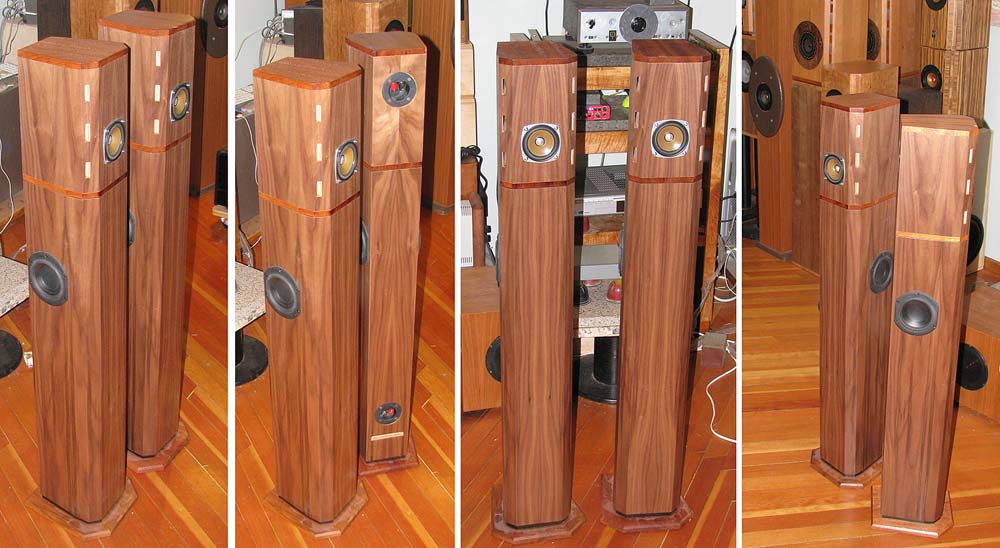
The holey driver brace features in nist of out boxes. It allows sharing of driver reactionary force across more panels to reduce the potential of box resonances being excited. Ithas proven to work very well but is fiddly to implement.
dave
I've used some bamboo plywood speakers for L/C/R in my home theater. They're not diy though. I think they use FE83en
Blumenstein Audio
Blumenstein Audio
Yes, Clark likes the FE83. Not really possible to get bass out of them. With the same alignment about an octave less extention then FF85wk.
I am not so thrilled about that driver, but the SOL version (FE88 SOL) is quite stunning.
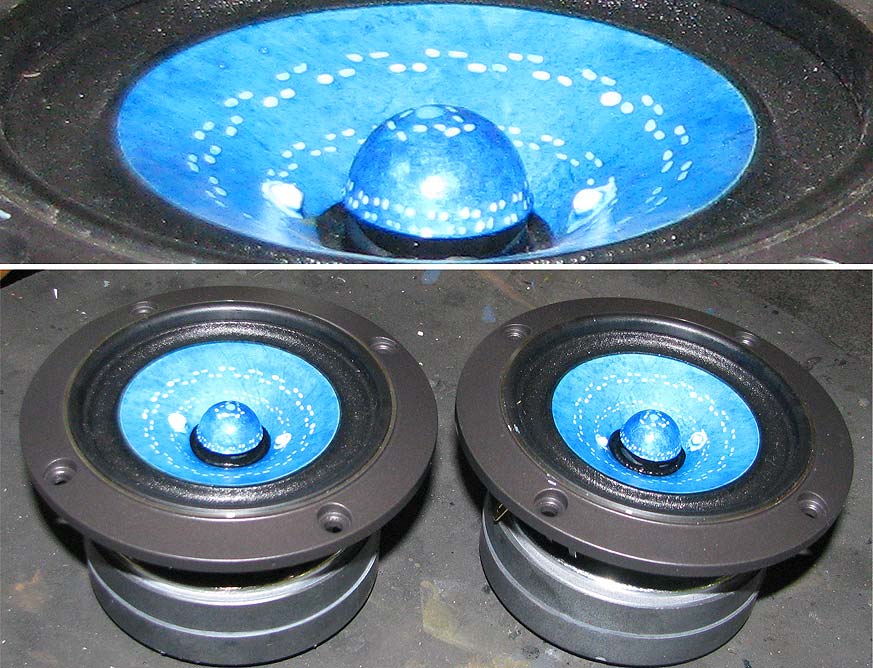
dave
I am not so thrilled about that driver, but the SOL version (FE88 SOL) is quite stunning.

dave
Yes, Clark likes the FE83. Not really possible to get bass out of them. With the same alignment about an octave less extention then FF85wk.
I am not so thrilled about that driver, but the SOL version (FE88 SOL) is quite stunning.
dave
Agreed. I had a subwoofer in the system, all hooked up to a receiver that had Audyssey correction. I think Audyssey had the crossover at 150Hz.
150Hz might be as high as Audyssey goes?
dave
Don't know if you're being a little sarcastic or not. Doesn't matter, I can take it.
I still have the speakers in a different system running full range, stereo only. If you know of an app (android) that can sweep frequencies and measure the response, I'd be excited to try that.
I have a neat app called spectroid that does measurement. Don't think it can output a sweep.
rif, I think Dave was simply referring to the XO points for mono blending of content to the LFE/“sub” channel line out. While the actual limits and labelling could vary amongst brands or model series, I think 200Hz is the highest on the Audyssey setting, with the lowest before “full band” or “large” being 40Hz. But there have been some receivers such as the Onkyo I’ve had for years now that allow for much higher XO frequencies when using the digital X/O mode for active bi-amping of front mains. This mode re-assigns the pair of amp channels otherwise defaulted to front height surrounds and is independent from the mono mixed LFE channel. I remember playing with that with the Elipsa and Alpair 12W/7 MTMs, where it worked well enough, set to 250Hz to compare with the two separate passive networks we were experimenting with at the time. Those big boys where quite capable of running full range, but IIRW, I still high passed them at the THX standard of 80Hz, as I’m currently doing with the Alpair10.3 Pensils.
Last edited:
If you’re running an iOS device, there’s some pretty nifty apps available from Studio6Digital; LARSA is their Loudspeaker and Room System Analyzer, @ $40 US. While you can use the mic built into your phone or iPad, I think you’d get better results with a calibrated unit.
Of course, this could certainly be an expensive rabbit hole in which to spelunk.
Studio Six Digital
Of course, this could certainly be an expensive rabbit hole in which to spelunk.
Studio Six Digital
I heard the whole WK range and love them. I find the slightly bigger 125WK most interesting because a noticeably fuller bass in only slightly bigger box and still all the treble you could wish. The 165 would benefit from a helping tweeter and the 225 definitely needs it.
Thanks for all the sugestions, i'm gonna get the thick wood kit to start with the ff85wk. Gonna relly on a subwoofer for some base .
Do you think that the woofer on the Altec Lansing system could be reused?
The amp part seams to be broken,but the driver was working fine.
I was thinking if i put the woofer in a sealed box,as a passive and get an amp that has power out for a passive subwoofer ,would it work?
The Altec Lansing is a 4 ohm 50w driver (A2875).
Do you think that the woofer on the Altec Lansing system could be reused?
The amp part seams to be broken,but the driver was working fine.
I was thinking if i put the woofer in a sealed box,as a passive and get an amp that has power out for a passive subwoofer ,would it work?
The Altec Lansing is a 4 ohm 50w driver (A2875).
it will be difficult to get that sub driver sounding smoothly with the FF85WK, in my opinion.
Getting a wooferto blend well with a FR requires they have fairly extended top.
dave
Yeah, ~flat to at least 500 Hz and personally prefer ~1 kHz with 'FR' drivers and considering the FF85WK's near zero Xmax, even this 'el cheapo' [in USA] suffices if he doesn't need to go below ~32 Hz: Dayton Audio DC160-8 6-1/2" Classic Woofer
Obi1Shinobi: What brands are readily available to you? Max driver only price?
Obi1Shinobi: What brands are readily available to you? Max driver only price?
Try a sealed sub with a pair of 6.5in or 8in polycone woofers. The idea is to find one with decent upper bandwidth without breakup. With a larger sealed box and separate amp and low pass filter (either active or passive) can get these to roll off slowly at 1st order to match the full range. I made a large sealed with dual $5 budget polycone 6.5in woofers used in Dayton’s famous budget $39 speakers and they sounded surprisingly good.
This was back on 2013 - these things were running full range and here was the measurement:
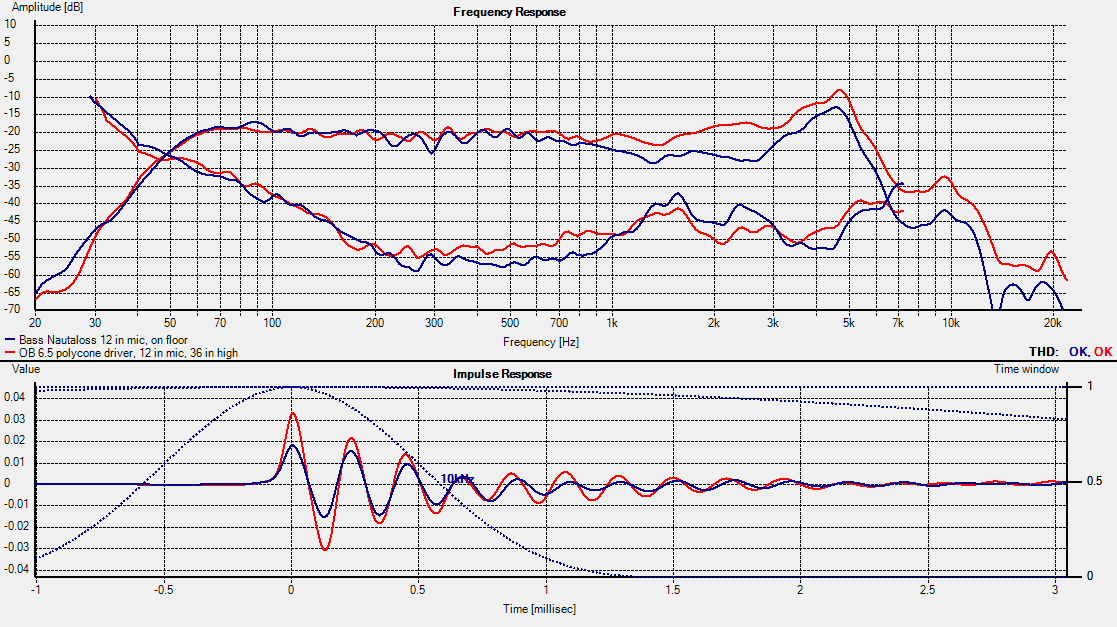
Here is 4 drivers in opposed push pull setup:
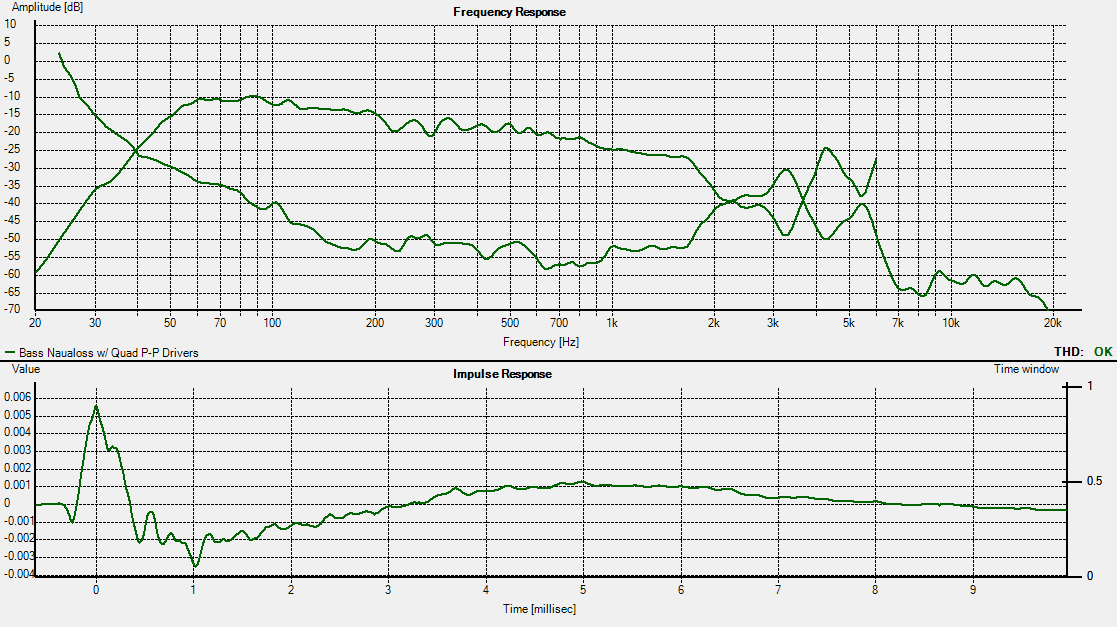
I made a fancy Nautaloss cabinet but a simple sealed box would have worked fine if stuffed with poly fill or fiberglass.
The Nautaloss Ref Monitor
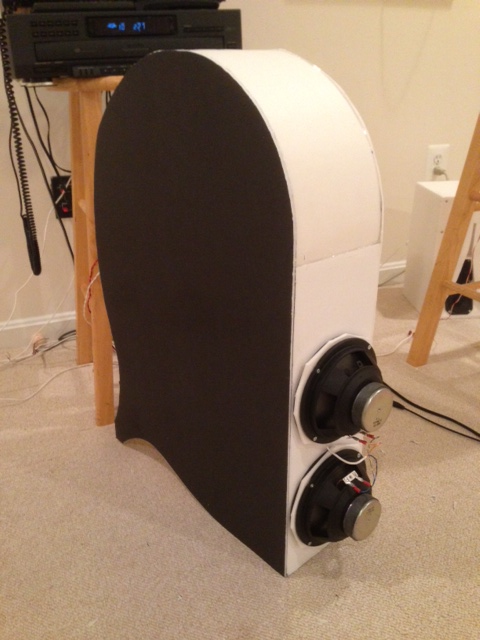
Look for auto-sound drivers with at least 50Hz Fs. They have high Qts which is what you want in order to achieve naturally deep bass in a sealed cabinet.
This was back on 2013 - these things were running full range and here was the measurement:

Here is 4 drivers in opposed push pull setup:

I made a fancy Nautaloss cabinet but a simple sealed box would have worked fine if stuffed with poly fill or fiberglass.
The Nautaloss Ref Monitor
Look for auto-sound drivers with at least 50Hz Fs. They have high Qts which is what you want in order to achieve naturally deep bass in a sealed cabinet.
Try a sealed sub with a pair of 6.5in or 8in polycone woofers
For example our Elipsa uses a pair of 7” SDX7eN, the A12pw MTM uses a pair of 6.5” A12pw in an ML-TL, Tysen V2 uses a pair of 5.2” woofers in an ML-TL, and the woofT for FF85wk uses a pair of Peerless 830870 in an ML-TL.
dave
I would also be adding in a 500uF bipolar capacitor in series to reduce intermodulation distortion when the sub is added, especially with the FF85WK. Two back to back electrolytics (1000uF each rated at >=25V would give a f3dB of 79Hz). If a proper active crossover is used (unlikely I would guess) this is not necessary.
- Home
- Loudspeakers
- Full Range
- Are Fostex FF85wk or FF105wk suitable for TV multimedia speakers?